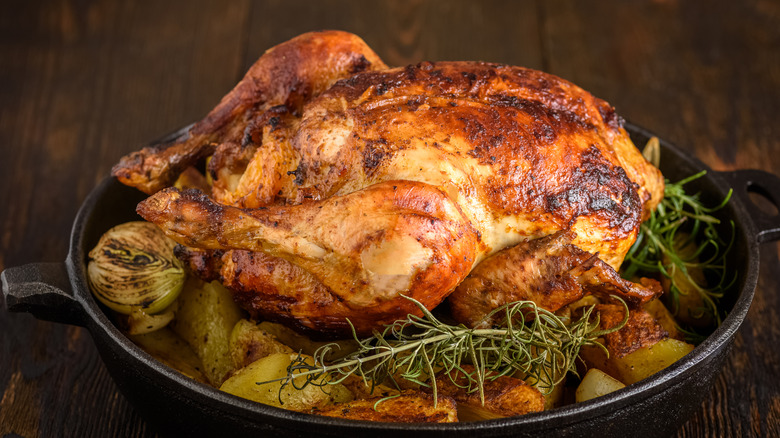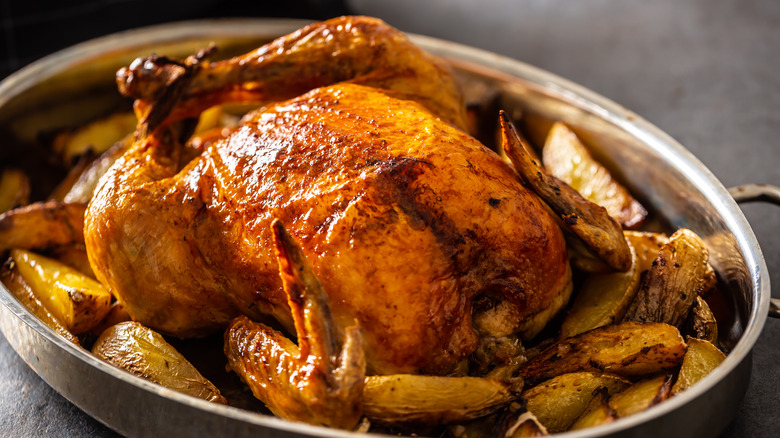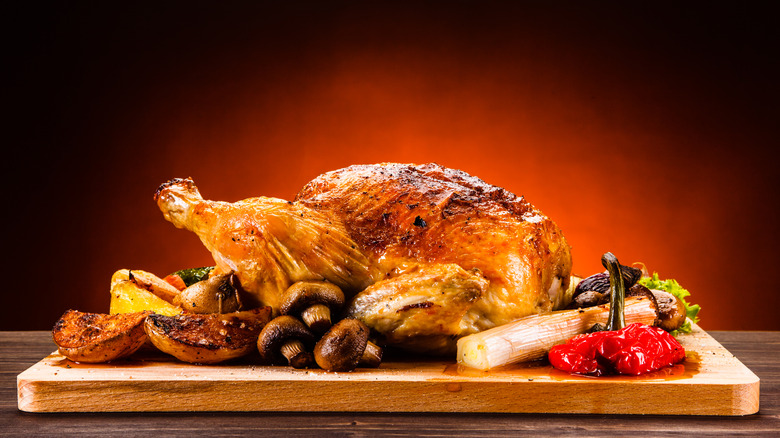The Compound Benefits Of Steam-Roasting Chicken
We may receive a commission on purchases made from links.
While frying and grilling chicken has its own set of perks, there's really nothing like digging into a hot and juicy roasted chicken. When paired with your choice of potato and a side vegetable, you have yourself a quintessential Sunday dinner. Juicy, tender meat underneath a flavorful crispy skin that's been covered in anything from herb butter to lemons, a roast chicken is a versatile dish that's filling and affordable.
There are many ways to make your chicken dinner, ranging from the obviously simple to the surprisingly complex. You could take Saveur's advice and "butterfly" or "spatchcock" your chicken, which involves splitting it by removing its spine and then flattening it out. While a bit more advanced than just tossing the chicken in the pot, this technique supposedly results in crispier skin and a shorter cooking time, as there's more surface area exposed to the heat. If you want a crispier skin on your chicken, Food Network suggests patting the chicken dry with a paper towel before baking and (optionally) refrigerating for a few hours afterward. These are all good methods to try, but what if it were possible to "roast" a chicken without really roasting it at all?
Some sources claim that by utilizing steam, you can "roast" a chicken and reap the juicy benefits without any drawbacks you might find when preparing it the conventional way.
How does steam help to roast a chicken?
When you think of conventional roasting, you usually picture putting something in the oven and letting the hot air crisp it up, like potatoes or in this case, chicken. But the steaming method uses a kitchen tool called a "Römertopf" – a type of clay or ceramic casserole dish with origins in Germany.
Food & Wine details how cooking chicken in a Römertopf works. The lid of the dish must first be soaked in water for at least 30 minutes before adding the chicken and being put in a cold oven. The extreme heat of a preheated oven may cause the clay or ceramic to crack from shock. Then you'll turn your oven on at 425 degrees. As the chicken cooks, the water inside begins to evaporate and form steam. The lid, being made of porous clay, helps to create gentle heat without letting the steam build-up. As excess moisture escapes, the heat from the steam roasts the chicken from all sides, keeping it moist without being raw or flabby. Once the thickest part of the chicken reaches 125 degrees Fahrenheit, remove the Römertopf cover and allow the chicken to finish cooking.
Unlike dry roasting, steam roasting prevents the chicken from drying out thanks to the circulation of heat and moisture. It also helps to keep certain juices and flavors in the chicken through the added bonus of "self-basting" it.
How does steam roasting self-baste chicken?
Basting is described by Rouxbe as being a method of cooking in which a liquid such as melted fat or juices is continuously spooned or poured over meat as it roasts. This process helps to give a crispier skin and allow some moisture to be reabsorbed into the meat– in this case, one would baste a chicken by pouring the chicken's own juices back over the meat as it cooks to keep it moist. But how exactly does steam-roasting "self-baste" the chicken as it cooks?
According to Food & Wine, the curved design of the Römertopf allows the chicken fats and juices to concentrate in the pan, rather than letting the juices boil off and evaporate. As the fat and juices collect, this mixture is reabsorbed back into the chicken, thus basting the chicken as it cooks. This process is unlike uncovered dry roasting, in which the chicken must be basted several times over to prevent the juices from evaporating and leaving you with a tough, dry chicken.
SF Gate tells us that steam-roasting a chicken is also a pretty healthy way to prepare your roast bird, as it avoids all the oils and fats one may use in other conventional cooking methods. After all, as far as we know, steam doesn't have any calories.


